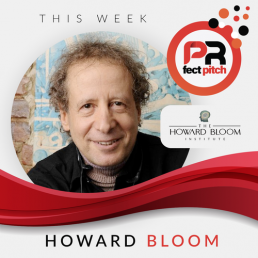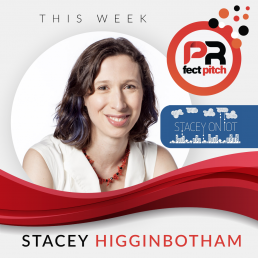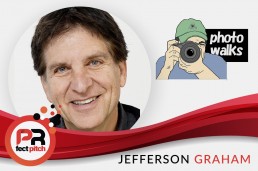Four Takeaways from PRfect Pitch Interview with Author, Publicist & Journalism Expert, Howard Bloom
PRfect Pitch focuses on interviewing media people and event managers who PR agencies pitch regularly on behalf of clients. We also like to bring in experts from the PR world, who have established practices that elevate the media relations discipline in general.
The podcast discusses how and when to pitch a story to editors and producers who in turn learn which PR sources can be trusted to bring them interesting stories that resonate with their audience.
Our 14th guest was none other than THE Howard Bloom. Howard is considered PR royalty, having worked with some of the most famous and infamous artists and musicians of 1970s and 1980s. In this episode, you’ll hear about how he carved a path from science to publicity, how he built an empire for himself and his clients, the practices he established, and what he believes is missing from the music industry today.
Aliens Are Assets
At the age of 10, Howard had developed a keen interest in microbiology and theoretical physics, learning from some of the most prestigious scientific minds on the East Coast in cancer research, dark energy, and space studies.
You know … your typical publicist background, right?
But Howard had also become fascinated with the “ecstatic experience” at an early age as well. This fascination is what eventually led him to a career as in PR. After receiving fellowship offers from a variety of scientific graduate programs, Howard chose to go in a different direction to chase these “ecstatic experiences.” After being named editor of the impactful Literary Magazine at NYU, doors started to open. He was given the opportunity to co-found an art studio, giving him special insights into the art and pop culture movements coming out of the heart of NYC. This allowed Howard to start the biggest PR firm in the music industry and establish a scientific approach to the methods that did and did not work to maximize his efforts.
Howard described himself as an “alien” coming into the music business with the mind of a scientist. But that mindset is what differentiated his firm from all others: the meticulous analysis of his business’ best practices elevated his firm to the very top of its sector. This shows that there’s something to be gained from outside perspective, and sometimes your biggest asset can come from the least likely of places.
“You Owe Your Audience Your Life”
Howard has worked with some of THE MOST iconic artists of modern times and knows firsthand the immeasurable influence they have on their fans and followers. He understands that a song goes far beyond its lyrics, beyond its production and performance. To become a true icon in Howard Bloom’s eyes, you must “become a steppingstone in which an entire generation of kids sees itself mirrored.”
As publicists and PR professionals, it’s our job to help our clients realize the impact they have on their audiences, regardless of if they are popstars, doctors or CEOs. We want to give voice to the disciplines they represent, as Howard did to the subcultures his clients represented. If they want to be true leaders in their respective fields, their audiences must know and respect them well beyond their mission statement.
Passion Makes Diamonds
Having worked with eccentric personalities like Prince and ZZ Top, Howard has experience sifting through anti-media sentiments to bring the very best out of his clients during interviews.
To do this, he sits down with each of them one-on-one to work through their stories and craft the narrative that lies behind their passions. Once he has all the pieces, he puts them together as part of a coherent and chronological story such that even the most mundane questions from media can receive thoughtful, provocative, and passionate responses. As publicists, we must make sure to stage these storytelling opportunities ahead of time to get the very best out of our clients during every interview.
Cultivate The Relationships
Howard once styled himself a “collector of souls.” He knew that the crux of his business lied between the relationships he built with his clients and those he built with his media contacts. The connections they would in turn make with their audiences were the fruit of his meticulous labor. At the end of the day, those connections are the heart of our business, and the soul of our practice.
~~~~~~
Do you have tips and tricks for PR professionals that you want to share? Whether it be about pitching, media relations, podcasting or more, we’d love to hear your thoughts! Drop a comment on this interview with Howard on YouTube, which can be found here!
You can also listen to this season of PRfect Pitch via Apple Podcasts, or your preferred podcast platform.
Four Takeaways From PRfect Pitch Interview with Editor & Publisher of Stacey on IoT, Stacey Higginbotham
PRfect Pitch focuses on interviewing journalists and other media people who PR agencies pitch regularly on behalf of clients. As the name implies, we like to deep-dive into what makes a “PRfect Pitch,” and the tips and tidbits that separate the good PR pros from the bad ones.
Our 15th guest was Stacey Higginbotham, seasoned tech journalist and Editor/Publisher of Stacey on IoT. She’s also the co-host of This Week on Google, and host of the IoT Podcast. She’s been covering technology and finance for over 20 years. In this episode, Stacey shares a little bit about her journey into journalism, what she believes are the hot topics of tomorrow, and some of the things that she never wants to see PR people doing ever again.
The Trends of Tomorrow
Stacey has written for publications such as Fortune (where she was a Senior Editor), Gigaom, PCMag, Business Insider and MIT Tech Review. To say the least, she knows a thing or two about tech trends. She believes the next few years will see some major developments on the Smart Home front, with companies starting to focus on the adaptability and accessibility of their products for a wider consumer base.
On the business side of things, Stacey talked a little about how we might be able to adapt to the extreme interconnectivity that comes with 5G networks. She says that the metrics the data points from these networks provide will be able to discern some of the external factors associated with production to optimize for things that go beyond the profit margin, such as employee wellness or carbon emission reduction.
How Many Lightbulbs, For One Good Story…
Stacey shared a wonderful story about a “PRfect Pitch” from Gazelle, a company that buys and sells used electronics. They pitched a story to her about the replacement of their management dashboards with a single Phillips Hue light bulb. As the bulb changed colors, the entire crew was made aware of the production line’s status for the day: on time, behind, or really behind. The bulb gives a signal that compounds information determined by the number of people working, the shipping backlog, the average productivity of the team, and the time USPS comes each day to collect the boxes. As it changes colors, management can quickly identify whether more people are needed on the production line, drastically improving production workflow.
It’s a beautifully simple story that starts with a lightbulb. But the PR contact that brought it to Stacey’s attention approached her honestly and transparently, refraining from linking any previous articles or showering her with false flatteries. He had a great angle, wrote a nice pitch, and it ended up in Fortune – it was that simple.
In short, it only takes one lightbulb to pitch one good story (but it must be a single Phillips Hue bulb).
Timing, Timing, Timing
To our great surprise, Stacey talked about the PR contacts that pitch her great stories but are unavailable to follow-up with a timely interview. She says this happens more often than we might think and she urges PR pros to prepare their clients for interviews within a few days before and after a big release. Otherwise, the news loses its pertinence and Stacey is left wondering why you didn’t reach out to her when your client was actually ready for an interview.
Coherence Is Key
When Stacey is looking into potential guests for her podcasts, she looks for spokespeople with three key features:
- An approachable dialect (given the complexity of her beat)
- Coherence of speech (such that they are intelligible to as many people as possible)
- Charisma and presence and a clear way of expressing their vision
Stacey made it no secret that she doesn’t often enjoy interacting with PR people, and that’s because the practices that’ve been used throughout the industry are wrought with inconsideration for media. That’s what we’re here to change, so that journalists like Stacey feel comfortable leaning into our support and utilizing us as resources rather than seeing us as antagonists.
~~~~~~
We want to hear your thoughts! Drop a comment on this interview with Stacey on YouTube, which can be found here!
You can also listen to this season of PRfect Pitch via Apple Podcasts, or your preferred podcast platform.
Four Takeaways from PRfect Pitch Interview with Former USA Today Columnist, Jefferson Graham
PRfect Pitch focuses on interviewing media and key event managers who PR agencies pitch regularly on behalf of clients. As the name implies, successful pitching is a key ingredient in achieving results as a public relations professional.
The podcast discusses how and when to pitch a story to editors and producers who in turn learn which PR sources can be trusted to bring them interesting stories that resonate with their audience.
Our 13th guest was Jefferson Graham, former USA Today tech columnist, host, and podcaster. He spearheaded the “Talking Tech” series until 2021 and is now the host of the travel photography series “Photowalks with Jefferson Graham” which streams for free on Tubi and he is also a current AARP contributor.
This is Not Your Typical Workday
Jefferson broke down what a typical workday looks like for him and revealed how jam-packed his days truly are: he wakes up at 5 a.m. every day and works until 10 p.m. every night. During the day, he’s busy crafting newsletters, editing videos, or filming his series.
As PR professionals, we have to be mindful and respectful of media members’ schedules, understanding that freelance journalists have less traditional workday structures than those working for national publications.
Be Mindful of Journalists on the Move
Since Jefferson took his leave from USA Today earlier this year, he has shifted towards freelance journalism while also hosting and producing “Photowalks with Jefferson Graham.”
As media relations specialists, it’s important to be aware of these kinds of career moves. If we reach out to Jefferson inquiring about a potential USA Today feature, the misinformation such a pitch is based on will prompt him to ignore it and that will damage the potential relationship from the start.
Automation Pitching is Fodder for Mockery
Jefferson admitted to getting hundreds of pitches sent to his inbox every day and can easily recognize when they’ve been sent by a human being versus a machine. He doesn’t direct them directly to his spam box, mostly because he enjoys getting a little laugh from the horrendous pitches he finds as he sifts through the hundreds of automated emails he gets daily.
The point? We’ve said it before, and we’ll say it again: blast pitching doesn’t work. It’s offensive to the journalists you are trying to reach and takes away the MOST IMPORTANT aspect of our jobs. That human touch, that authentic relationship, this is what differentiates the best PR pros.
Journalistic Freedom Narrows Angles
Now that Jefferson has left USA Today, he has become much more selective about the stories he decides to write about. He limits himself to topics he is particularly interested in, and no longer answers to the ever-unsatiated needs of the USA Today media wheel.
The takeaway here is that media relations specialists need to find ways to dig deeper into the specific interests of journalists like Jefferson Graham, to see if their stories truly align with their newfound writing independence. It’s not enough to go to his USA Today column archive and see that he’s covered Microsoft in the past. The question becomes, would he be interested in covering it now? Because the answer is, most likely, no. So why waste everyone’s time?
Do your research, know your targets.
~~~~~~
Do you have tips and tricks for PR professionals that you want to share? Whether it be about pitching, media relations, podcasting or more, we’d love to hear your thoughts! Drop a comment on this interview with Jefferson on YouTube, which can be found here!
You can also listen to this season of PRfect Pitch via Apple Podcasts, or your preferred podcast platform.




